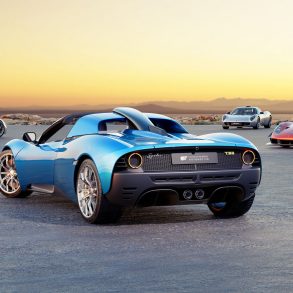Forged by the wind and born for the road. The McLaren P1 is a member of the new generation supercars and a pinnacle of British engineering. It joins the ranks of the ‘gold standard’ hybrid supercars formed in 2013 like the Ferrari LaFerrari and Porsche 918.
Supercars prior to the McLaren P1 were somewhat similar in construction -they featured either naturally-aspirated or turbocharged engines that produced tremendous amounts of power, but generally speaking none of them could be classified as revolutionary or groundbreaking.
A new era of supercars arose in 2013 — hybrid supercars like the P1 began taking advantage of combining the internal combustion engine together with new technological electric engines. The result delivered a performance to levels unseen before, particularly for road-legal cars.
Among the three hybrid supercars released in 2013, the McLaren P1 production numbers makes it the rarest and perhaps its design features commands it first place as the best-engineered, even by today’s standards.
The McLaren P1 was introduced at the Paris Motor Show in September 2012, and production was launched the following year. Although McLaren had 750 letters of interest, production of the P1 was limited to 375, with production concluding in early December 2015.
The name P1 comes from the Formula One pole position and continues the naming similar to its predecessor, F1.
The original price of the P1 was approximately USD1.15 million back in 2013, however in 2019, Bonhams auctioned a P1 that had done 923 kilometres for approximately USD 1.9 million – quite a nice appreciation.

Designed for Speed
Everything about the P1 speaks speed and performance, and first glimpse of the car leads the observer in no other direction.
105 workers spent 800 man-hours to produce one McLaren P1 with each P1 taking approximately 17 days to complete from start to finish.
The exterior painting itself could take up to five days, depending on the specification and customer requirements, but yellow was the most desired color nonetheless.
Just about every P1 rolled out of production has been custom-made and modified in McLaren’s Special Operations Department, so no two are the same.
The first specimen that drove out of the factory was completed in September 2013 and was finished in silver with contrasting carbon fiber accessories. The last P1 ever made was painted in a unique pearl orange color with exposed carbon fiber details, silver rims, and a special passenger cabin marked by carbon fiber shell seats and black/orange Alcantara upholstery.
Internally the focus is on performance as you will not find a glove box nor the need for carpets. In fact, to save approximately 1.5 kilograms of weight, designers chose not to lacquer or paint the carbon-fiber interior trim.

Further weight savings may be found all around the cabin in the glass. The toughened glass that forms the canopy above the driver’s head is just 2.4mm thick. Only marginally thicker is the windscreen at 3.2mm thick that also has a combined plastic interlayer that assists in saving 3.5kg.
Digging deeper into the construction of the P1 and you will find the whole ‘MonoCage‘ carbon fiber chassis weighing just 90kg. The exterior body consists of only five panels, reducing the requirements for bolts and joins that increase weight.
All these clever design characteristics delivers a car that despite having a bank of batteries and two engines, a weight of only 1547kg — less than a modern sedan!
Performance using Hybrid Technology
The long-awaited successor to the McLaren F1 features two engines, both of which work jointly to deliver an outstanding 916 horsepower and 980 Nm of torque.
The majority of the power is generated by its twin-turbocharged 3.8L V8 engine. This delivers 727 horsepower at 7500rpm, with the remainder being provided by an additional electric motor (176 horsepower).
It only takes the McLaren P1 less than three seconds to reach 100 km/h (distance of about 30 meters). Keep the foot down and within 14 seconds you will be driving at a speed of 300 km/h.
The top speed was limited to 350 km/h, and as a marker of performance, it dominates its predecessor — the McLaren F1 needed about 23 seconds to reach the 300 km/h mark.
This amazing achievement has been made possible by the utilization of its two engines working together to fix each other’s weakness.

Electric engines are known for their instant torque and power delivery which is something that not even the best combustion engines can achieve. The electric engine in the P1 acts as a partner to the V8 combustion engine and it actually comes into effect during all the combustion engines shortcomings like the turbo gap. This gives the powertrain an effective powerband of almost 7,000 rpm.
Formula One Features
The P1 offers many parallels to Formula 1 race cars. For example the car features an ‘instant power assist system’ (IPAS). At a touch of a button, the driver can activate the IPAS which immediately unleashes the full power of the electric motor, catapulting the car down the road.
The P1 also features the kinetic energy regeneration system (KERS) which also features in racing and formula one cars. Activating the KERS reduces the inclination of the rear air stabilizer by 23%, thereby enhancing stability and the ability to achieve higher speeds. The amount of downforce that the P1 can provide is 600 kg in race mode, which is a figure only some racing cars in the famous races in Le Mans can boast of.
Designing the McLaren P1
The P1 is a classic example of the ‘form follows function’ mentality. McLarens aerodynamics team and engineers worked side by side with the design team to ensure that the design was going to support and enhance its performance goals.

Designers working on the P1 had to be completely performance-orientated which is challenging for any design team. The result was the delivery of a vehicle blending performance, engineering and futuristic aesthetics.
Designer Paul Howse, whose original concept theme was eventually chosen stated “It’s about design not styling. You could draw something that looked awesome, but it would be a show car with no function. It wouldn’t be able to achieve what this car achieves as a complete package”.
Inspired by Nature
The inspiration behind the design of the P1 was drawn from nature. Marine life to be exact.
Frank Stephenson, design director of McLaren Automotive, while on holiday in the Caribbean, observed a sailfish on a wall in the resort. A man working at the resort proudly told him how he was excited to have caught the sailfish given its speed. Stephenson intrigued by this statement — began researching what gave the sailfishes ability to be so quick.
McLaren’s designers applied the sailfish scales texture to the inside of the ducts that lead into the engine of the P1. The end result is a 17% increase in air volume going into the engine, and thus improving efficiency.
The P1 also utilized the sailfish little ‘diplets’ on the torso of the fin where it meets the tail fin. These ‘diplets’ straighten out the flow of pockets of air, a property implemented into the P1 to make the car more aerodynamic.
Watch Frank Stephenson explain his design techniques of incorporating ‘biomimicry’ into the McLaren P1.
Carbon Fiber Everywhere
Almost everything from the body to the interior of the P1 is made out of carbon fiber. Over 200 separate components have been molded into just three larger pieces consisting of the rear, the central ‘monocage’ and the frontal bodywork. All three are incredibly light as the P1 panels only weighs 1.5 kg per square meter.

To save weight further, even the seats are nothing more than thin carbon fiber shells filled with high-density foam.
McLaren P1 GTR and LM
25 years ago McLaren presented the incredible racing version of the F1, called the F1 GTR. 20 years later in 2015, due to popular demand from P1 owners, McLaren presented the P1 GTR.

McLaren believes the P1 GTR is the best car for the racetrack. If the standard P1 with 375 models produced is exclusive, the P1 GTR was produced in an even more limited number. Only 58 of them were made and were only sold to owners of the previous P1 model.
The P1 GTR takes on a more aggressive design. Exterior features includes a new GT front spoiler, large rear spoiler, and rear diffuser. In contrast to the road-going McLaren P1, the P1 GTR has a fixed-height wing which sits more than 400mm above the sculpted rear bodywork — an increase of over 100mm of the adjustable wing.
The side windows differ from the P1 by having motorsport-specification polycarbonate with a sliding ‘ticket window’ on the driver’s side. The toughened glass panels in the roofs canopy have been replaced with carbon fiber panels to give the cabin a more enclosed, cocooned environment. The weight saving measures on the McLaren P1 GTR combine to strip out a further 50kg over the road based model.
Working in conjunction with the front-mounted aerodynamic flaps ahead of the front wheels, the rear wing adds further downforce by more than 10 percent – meaning up to 660kg at 150 mph.
For even better racing properties, McLaren increased the engine power to 986 hp. Whether they optimized the electric engine or the V8 engine has not been disclosed by McLaren.
McLaren P1 LM
The McLaren P1 LM is a series of just five (6 including the prototype) sophisticated cars from the hands of the masters of the accredited workshop Lanzante Motorsport.
It is actually a heavily redesigned road-legal version of the P1 GTR, which differs from it in even lower weight (saving 60kg) and even better racing aerodynamics . The engine remains the same, so performance figures are the same as those of P1 GTR.
McLaren P1s Racing History
Due to the exclusivity and low production figures, the P1 was never used in serious racing events and leagues.
It did however set many track records including the record of the “green hell” in 2017. The P1 is also regularly seen used on tracks across the world by owners who actually wish to drive their cars like they were meant to be driven.
The McLaren P1 has so far been the record-holder among production cars on four world-famous tracks, including the “home” track Silverstone.
On 27 April 2017, the prototype P1 LM, XP1 LM, beat the production road car lap record time at the Nürburgring Nordschleife, with a time of 6:43.22. Behind the wheel sat Kenny Brack, the 1999 Indianapolis 500-mile winner and the 2009 Rally X gold medal winner at the X-Games.
The car involved was running on Pirelli’s road-legal Trofeo tires. Kenny Brack is also an official McLaren test driver so the P1 must have felt like home for him. Even though the record of the P1 does not hold anymore, the time it achieved is still amazing by today’s standards.
The P1 is nothing short of brutal. The sheer amount of power being sent to the rear wheels was and still is completely mind boggling. The beauty of the P1 was also in its versatility — a rare supercar that provides comfort driving in the city but also produces the exhilaration when driven hard on the track.










